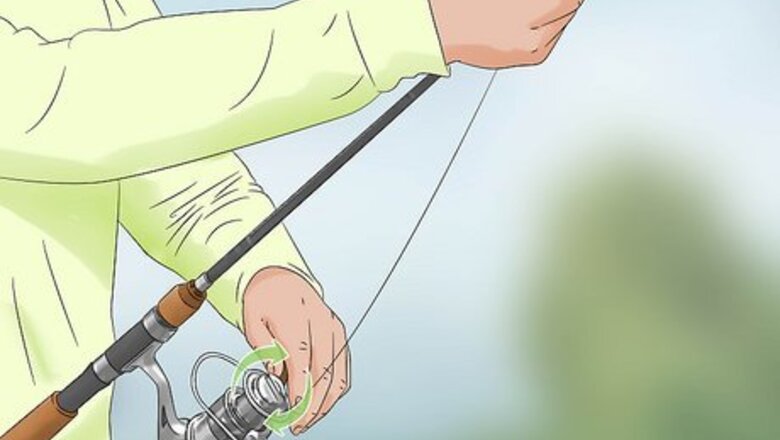
views
Thread your line through the reel and rod.
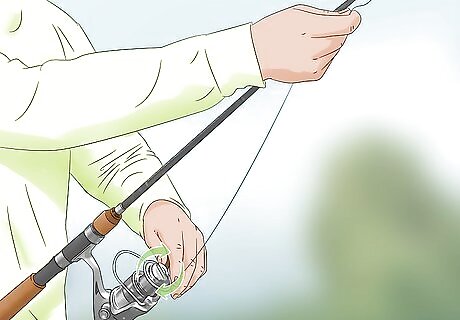
Get your line rigged up before you attach anything to the end. Choose a line that’s made for the type of water you’re fishing. Spool the line onto the reel first before running it through your rod. Make sure you run the line through all the guides so you can cast consistently.
Tie your hook to the end of the line.
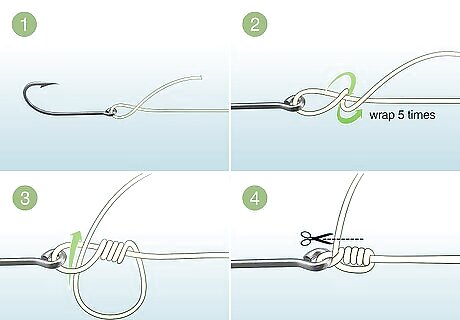
Starting with the hook makes it easier to put the bobber in the right spot. Since you’ll need a few inches of extra line to tie on your hook, it’s easier to judge where to place your bobber afterward. Use a clinch knot to secure your hook to the end of your line so it doesn’t come undone when a fish bites. Be sure to trim off any excess line that hangs from the hook when you’re done. Use a hook size that’s meant for the fish you’re trying to catch. For example, a #2 hook works well for walleye and anywhere between #1 and #2/0 is great for bass.
Attach a sinker above the hook.
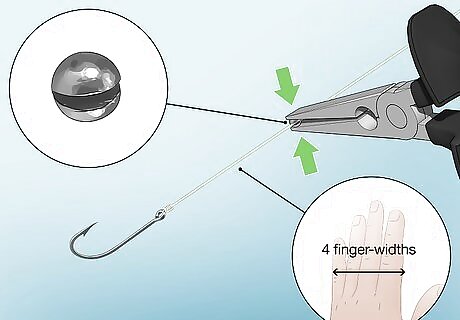
A sinker keeps your hook underwater so it doesn’t float up. Sinkers are additional weights you can easily clip onto your line. Place the sinker about 4 finger-widths up from the top of the hook and slide the line into the groove. Use a pair of needlenose pliers to pinch the sinker closed around the line. Choose a sinker that’s enough to hold your line down, but not so heavy that it pulls the bobber underwater. If you notice your bobber dipping below the surface after you cast, you may need to use a lighter sinker. Try using an ⁄8 oz (3.5 g) sinker for shallow water. For deeper water, put on a ⁄4–⁄8 oz (7.1–10.6 g) sinker instead.
Choose the smallest bobber that stays afloat.
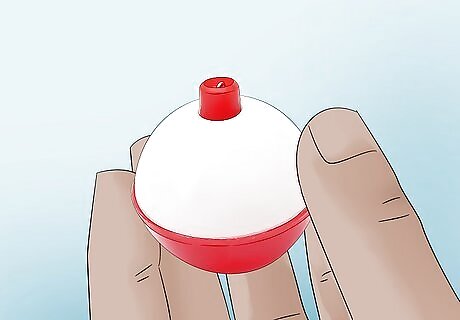
Large bobbers are not as sensitive when a fish strikes. Even though it’s easier to see big bobbers out on the water, smaller fish might not pull them underwater so it’ll be harder to know when you have a bite. Start with a small round bobber, and try one that’s larger if it sinks from the weight of the bait, hook, and sinker. If you’re fishing in deep water, you’ll need a larger bobber so it’s easier to see. As a general rule, larger bait will need a bigger bobber. There isn’t an exact science to picking the right size, so you may need to try a few different bobbers out to see if they’ll work.
Place a fixed bobber 3–4 ft (0.91–1.22 m) above your hook.
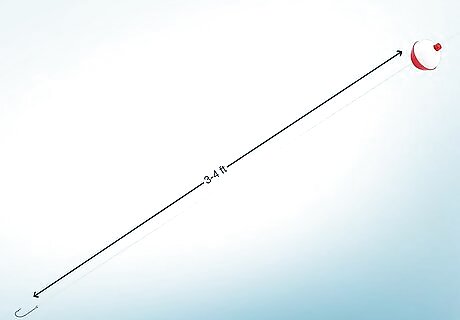
A little space between the hook and bobber keeps you from scaring fish. The length of line below your bobber determines how deep your hook will go. Most shallow-water fish swim a few feet below the surface, so measure up from the top of the hook and pinch the line so you don’t lose your place. Keep the water conditions in mind when you’re attaching your bobber. If you’re fishing in an area with a lot of weeds or underwater debris, you may want to shorten the line below the bobber to 1–2 feet (30–61 cm). Putting your bobber much higher on the line makes it difficult to cast properly. If you want to fish in deeper water, you’ll have to use a slip bobber setup instead.
Clip the bottom of the bobber to the line.
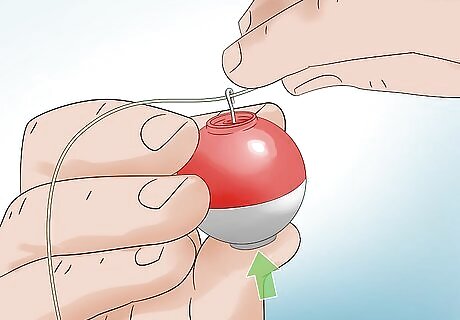
You may need to press a button down to expose the hook. Locate the cylindrical button on top of the bobber and push it down with your finger to pop the hook out on the bottom. Wrap your fishing line once or twice around the hook. When you let go of the button, the line will get pulled in and stay securely in place.
Thread the line through the hook on top of the bobber.
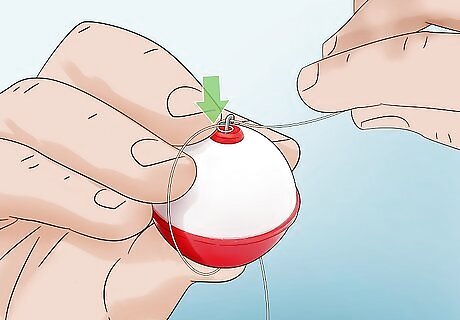
The line will clip in without tying any knots. Put your thumb over the bottom of the bobber to hold your line in place. Pull the line tightly against the side of the bobber up toward the top cylinder. Use your fingernail to press the edge of the cylinder down and expose the hook. Wrap the line around the hook a couple of times before letting go of the button. You can tie an overhand knot for added security to keep your bobber from moving further up the line, but it’s not necessary.
Unclip one end of the bobber to change its position.

Moving the bobber lets you easily adjust the depth of your hook. If you ever want to fish in shallower or deeper water, press down on the button again to expose the hook. Unloop your fishing line and you'll easily be able to move your bobber further up the line or closer to the hook. Once you have the bobber in position, clip it back to the line.
Secure a pencil-style bobber for more sensitivity.
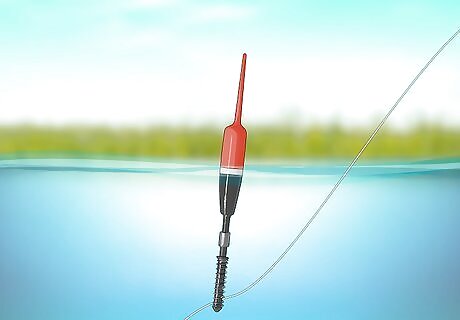
Pencil bobbers are lightweight, so slight movements pull them under. Pencil bobbers have long ends that stick out of the water and they’re more likely to tip or go under when a fish bites. To attach a pencil bobber, push the spring on the end up to expose the hook underneath. Loop your fishing line 2–3 times around the hook before letting go of the spring. Pencil bobbers work great for trout, crappie, perch, and bluegill.
Use a transparent bubble bobber to avoid spooking fish.

Transparent bobbers look like air bubbles so fish won’t notice them. Bubble bobbers will either clip in like a standard round bobber, or they may slide directly onto your line. If you don’t see any clips, then you’ll just slide the bubble bobber onto your line before you tie on the hook and set its position. Try a bubble bobber for panfish or trout.
Try a slip bobber to fish in deeper water.
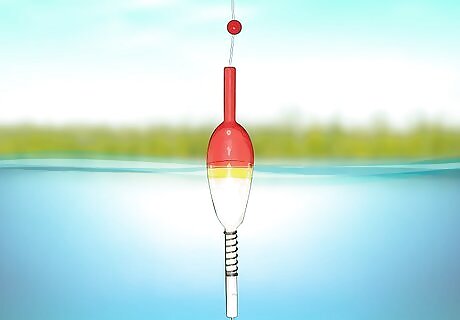
Slip bobbers slide up and down the line to adjust to the water depth. Since slip bobbers can move around, attach a rubber bobber stop to your line at the maximum depth that you want your hook to sink. Then, slide your slip bobber onto the line so it’s against the stop. Finally, attach your sinker to the line about 1 foot (0.30 m) below the bobber before attaching your hook. Slip bobbers work well for any type of fish, but especially for deep-sea fishing.
Hook a small piece of bait on your line.
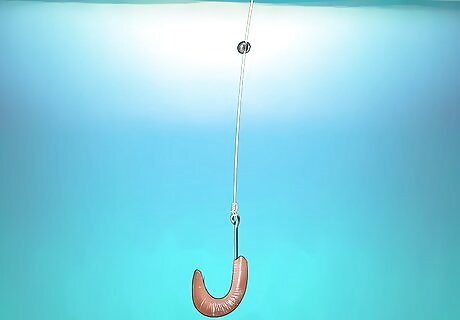
Smaller bait makes it easier for fish to eat. Using a full worm when you bait your line could let the fish nibble off pieces without actually setting the hook. Rip off a portion of your bait that’s about 1 inch (2.5 cm) long. Slide the bait onto your hook to cover up the barb so it’s less likely that fish will see it. It’s okay to attach full minnows to your line as bait.















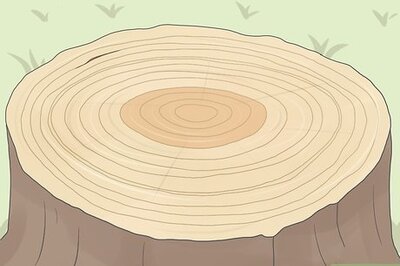



Comments
0 comment